ASUS EeePC 1215N: Bringing NG-ION to the 1201
by Vivek Gowri on November 25, 2010 12:00 AM ESTHow Does the ASUS Eee PC 1215N Perform?
Here’s the perplexing bit about the dual-core Atom. It’s a dual-core processor so you think, “Oh, so maybe Atom will be finally decent,” but then you realize it’s still a dual-core Atom. Two super slow cores won’t be any better than one if all you’re doing is navigating Windows and surfing the web (or any other generally single-threaded task). So on to the benchmarks.
Compared to the Atom 330 in the 1201N, we see roughly 10% increases across the board with the D525, which is basically just the clockspeed increase (1.8GHz versus 1.6GHz). Atom is seriously just Atom; not much has changed.
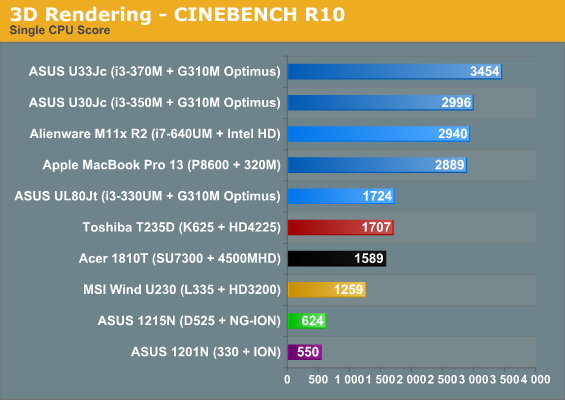
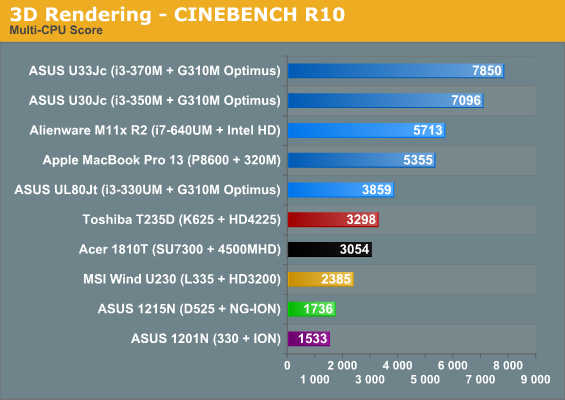
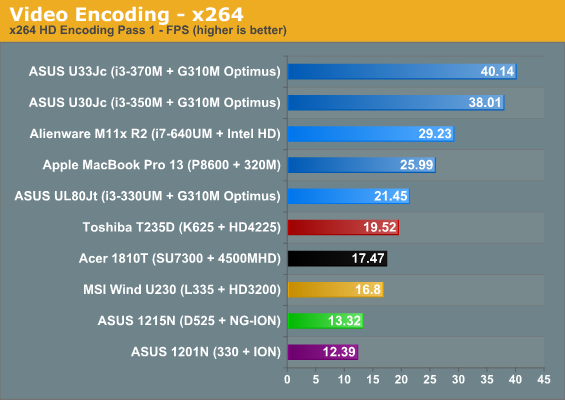
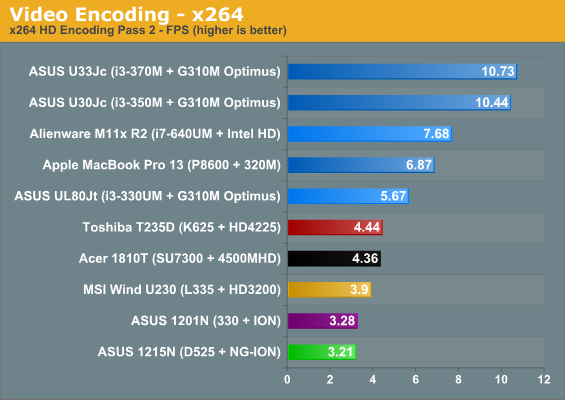
This is the problem with Atom though, right? Intel has essentially left the Atom core the same since the launch in mid-2008; other than the Pine Trail update that brought the IGP onto the CPU die and cut power consumption, we’re basically running the same Atom that ASUS and MSI made ubiquitous in the Eee PC 1000H and the original Wind. That’s why collectively we’ve been so “meh” on netbooks as a whole—while the original Atom was a nice step up from the woeful Celeron M ULV from bygone eras, it simply didn’t offer enough performance to satisfy our craving for decent CPU performance. And two years later, we’re still saying the same thing. Atom has not changed a whole lot since then, so hopefully AMD’s upcoming Ontario platform can kick Intel’s Atom team into gear and get them to really innovate in the forthcoming revisions.
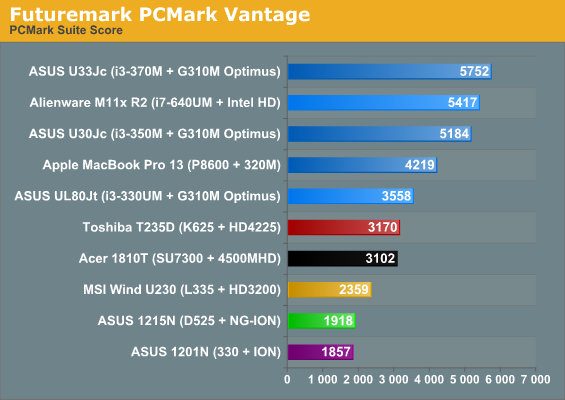
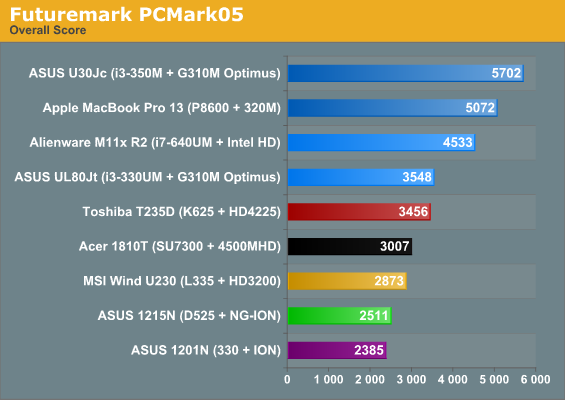
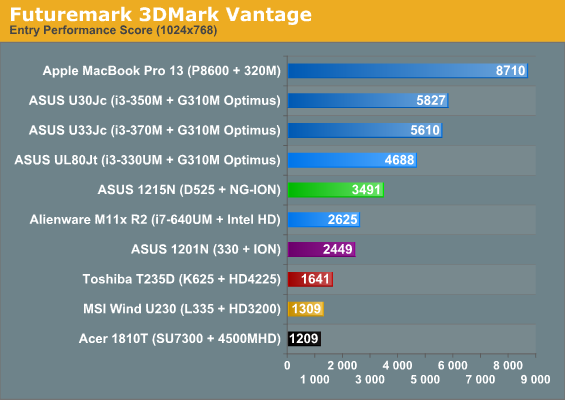
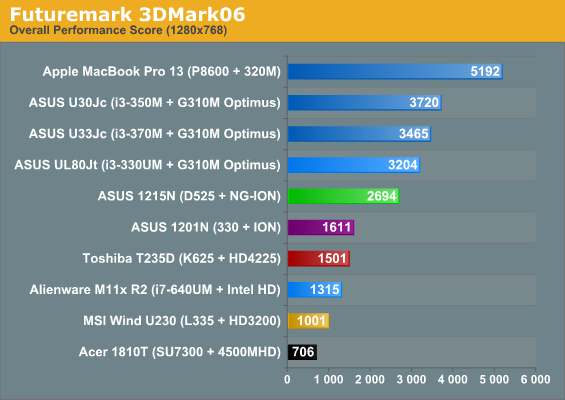
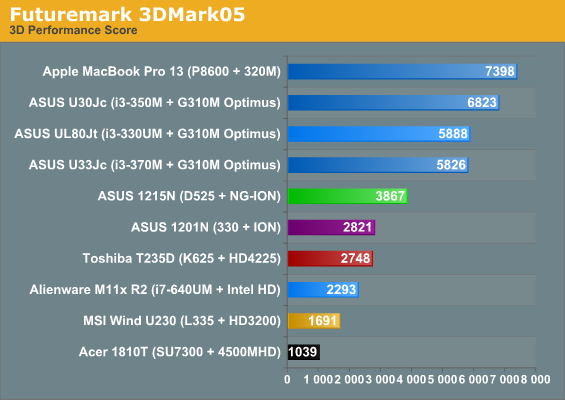
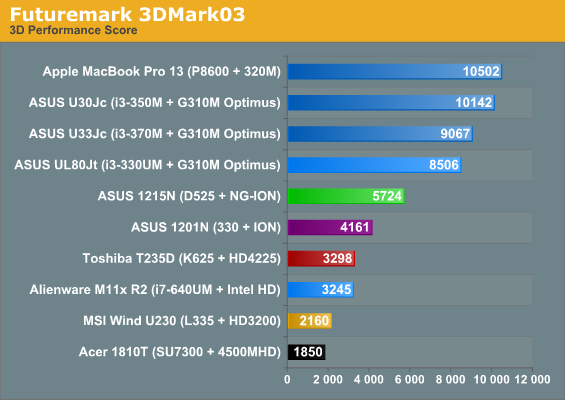
So far we haven't seen anything to impress, but here's our first hint that the 1215PN might be better than other netbooks: all of the 3DMark suites put performance a fair jump up from AMD's Nile platform. Can the 1215PN handle some moderate gaming? Let's find out....










41 Comments
View All Comments
MeSh1 - Thursday, November 25, 2010 - link
" Intel has essentially left the Atom core the same since the launch in mid-2008" This is what happens when there is no competition.Alexstarfire - Thursday, November 25, 2010 - link
True, there aren't other netbooks without atom, but there are other CPUs to compete. Unfortunately they all suck. All of the "competitors" use more power, save for ARM processors. Not sure if they'll ever use ARM processors in netbooks though. Tablets and smartphones seem to promising for them.VivekGowri - Thursday, November 25, 2010 - link
No x86 license means no ARM netbooks. Qualcomm was trying to get the whole "smartbook" deal off the ground, basically just thinner netbooks running Snapdragon and either Linux, Chrome OS, or Android. They all sucked big time, then the entire segment got basically axed for tablets. Toshiba released this Tegra 2/Android smartbook, but it hit the market and basically disappeared, so that says enough about the segment.We'll see, I'm interested to see if AMD's impending release of Ontario can change anything, but the Ontario cores are clocked at a pitiful 1.0GHz (for the dual core, 1.2GHz for the single) so it might not beat Atom by too much. For single core apps, I'm thinking maybe a 20% boost in performance - whether this will be faster than Atom by enough to be usable is the question. But seriously, I would like for something (anything) to kick the Atom team into action. They basically created the netbook market with the release of Atom, but after that they've done nothing other than moving the graphics onto the CPU package. Every time I get a netbook, it's like "oh boy, Atom....again....greaaaaat" I want some interesting netbooks lol.
Eug - Friday, November 26, 2010 - link
Non-Atom netbooks already exist in 2010. The Acer listed in the review is arguably in this netbook/hybrid class, at 11.6" inches with a street price LESS than the Asus Atom/ION machine, but sporting a CPU that runs circles around Atom and which also has an integrated GPU (Intel 4500MHD) with full 1080p H.264 decode capability like NVIDIA ION provides.Hopefully 2011 will see more of these decently powered netbooks, whether it'd be with CULV Core 2 Duo class chips, or from Zacate, beginning in the sub US$400 price segment.
Actually, just as important as the CPU is the keyboard. Using 10" keyboards is utterly painful. Just one and a half inches more and you get a full-sized keyboard. It makes all the difference in the world, not for productivity apps, but for basic netbook-style internet consumption as well. It's much more pleasant typing an AnandTech comment on a full-sized keyboard. For this reason, any 10" model IMO isn't even in the running compared to the Asus 1215N, regardless of performance.
Terodius - Thursday, November 25, 2010 - link
you do realize Sony has a 13.3 inch vaio with core i7, nvidia discrete graphics and a full HD screen? I mean seriously... netbook on steroids? I consider 12 inches more of a ultraportable. with another extra inch you get the experience of a desktop replacement.monomer - Friday, November 26, 2010 - link
Did you seriously just compare a $500 netbook to an $1800 laptop?Well played.
jigglywiggly - Thursday, November 25, 2010 - link
THIS LAPTOP BE DISSAPOINTATOM SUX GTFO
damianrobertjones - Thursday, November 25, 2010 - link
What?erwos - Thursday, November 25, 2010 - link
I ordered a 1215N, but promptly returned it unopened after finding out online about the number of people who are breaking the flimsy power pin in the course of normal use. This is a very serious issue that needs to be addressed in the review.Scott_G - Friday, November 26, 2010 - link
Why wouldn't you just give it a try on your own, you can't always believe what people say on the Internet about defects. If you did believe everything then you wouldn't own anything tech related.